
A knot is an intentional complication in cordage which may be practical or decorative, or both. Practical knots are classified by function, including hitches, bends, loop knots, and splices: a hitch fastens a rope to another object; a bend fastens two ends of a rope to each another; a loop knot is any knot creating a loop; and splice denotes any multi-strand knot, including bends and loops. A knot may also refer, in the strictest sense, to a stopper or knob at the end of a rope to keep that end from slipping through a grommet or eye. Knots have excited interest since ancient times for their practical uses, as well as their topological intricacy, studied in the area of mathematics known as knot theory.
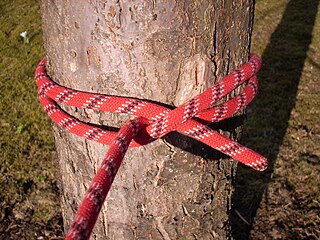
The clove hitch is a type of knot. Along with the bowline and the sheet bend, it is often considered one of the most important knots. A clove hitch is two successive half-hitches around an object. It is most effectively used as a crossing knot. It can be used as a binding knot, but is not particularly secure in that role. A clove hitch made around the rope's own standing part is known as either two half-hitches or buntline hitch, depending on whether the turns of the clove hitch progress away from or towards the hitched object.
Although the name clove hitch is given by Falconer in his Dictionary of 1769, the knot is much older, having been tied in ratlines at least as early as the first quarter of the sixteenth century. This is shown in early sculpture and paintings. A round turn is taken with the ratline and then a hitch is added below. The forward end is always the first to be made fast.
The difference between two half hitches and the clove hitch is that the former, after a single turn around a spar, is made fast around its own standing part, while the latter is tied directly around the spar.
A whipping knot or whipping is a binding of marline twine or whipcord around the end of a rope to prevent its natural tendency to fray.

The taut-line hitch is an adjustable loop knot for use on lines under tension. It is useful when the length of a line will need to be periodically adjusted in order to maintain tension. It is made by tying a rolling hitch around the standing part after passing around an anchor object. Tension is maintained by sliding the hitch to adjust the size of the loop, thus changing the effective length of the standing part without retying the knot.

The pile hitch is a kind of hitch, which is a knot used for attaching rope to a pole or other structure. The pile hitch is very easy to tie and can be tied in the bight, without access to either end of the rope, making it a valuable tool.
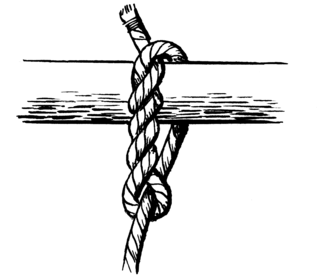
The timber hitch is a knot used to attach a single length of rope to a cylindrical object. Secure while tension is maintained, it is easily untied even after heavy loading.

The Munter hitch, also known as the Italian hitch, mezzo barcaiolo or the crossing hitch, is a simple adjustable knot, commonly used by climbers, cavers, and rescuers to control friction in a life-lining or belay system. To climbers, this hitch is also known as HMS, the abbreviation for the German term Halbmastwurfsicherung, meaning half clove hitch belay. This technique can be used with a special "pear-shaped" HMS locking carabiner, or any locking carabiner wide enough to take two turns of the rope.
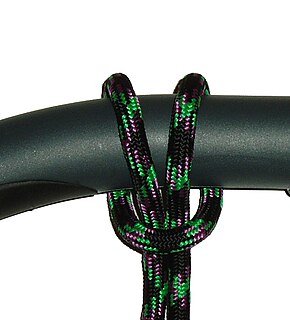
The cow hitch, also called the lark's head is a hitch knot used to attach a rope to an object. The cow hitch comprises a pair of half-hitches tied in opposing directions, as compared to the clove hitch in which the half-hitches are tied in the same direction. It has several variations and is known under a variety of names. It can be tied either with the end of the rope or with a bight.

The buntline hitch is a knot used for attaching a rope to an object. It is formed by passing the working end around an object, then making a clove hitch around the rope's standing part and taking care that the turns of the clove hitch progress towards the object rather than away from it. Secure and easily tied, the buntline hitch will jam when subjected to extreme loads. Given the knot's propensity to jam, it is often made in slipped form.
The buntline hitch, when bent to a yard, makes a more secure knot than two half hitches, but is more liable to jam. It differs from two half hitches in that the second half hitch is inside instead of outside the first one.
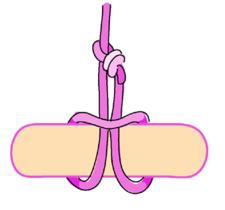
The bale sling hitch is a knot which traditionally uses a continuous loop of strap to form a cow hitch around an object in order to hoist or lower it. In practice, a similar arrangement can also be formed using a fixed loop at the end of a rope. This loop could be formed at the end of a line with a knot, such as the bowline, or a large eye splice.

The rolling hitch is a knot used to attach a rope to a rod, pole, or another rope. A simple friction hitch, it is used for lengthwise pull along an object rather than at right angles. The rolling hitch is designed to resist lengthwise movement for only a single direction of pull.

A Prusik is a friction hitch or knot used to attach a loop of cord around a rope, applied in climbing, canyoneering, mountaineering, caving, rope rescue, ziplining, and by arborists. The term Prusik is a name for both the loops of cord used to tie the hitch and the hitch itself, and the verb is "to prusik". More casually, the term is used for any friction hitch or device that can grab a rope. Due to the pronunciation, the word is often misspelled Prussik, Prussick, or Prussic.

Two half-hitches is a type of knot, specifically a binding knot or hitch knot. One variety consists of an overhand knot tied around a post, followed by a half-hitch. This knot is less often referred to as a clove hitch over itself, double half-hitch, or full-hitch.
Two half hitches is the commonest of all hitches for mooring in particular and also for general utility. Steel gives the name in 1794. The difference between two half hitches and the clove hitch is that the former, after a single turn around a spar, is made fast around its own standing part, while the latter is tied directly around the spar.
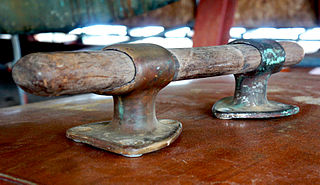
In nautical contexts, a cleat is a device for securing a rope.
The magnus hitch is a knot similar to a rolling hitch or clove hitch, used to tie a rope or line to a pole, spar, or another line. It is tied similarly to a rolling hitch but with the final hitch in the opposite direction. It can be more tricky to snug up, since both lines emerge from the same side of the hitch, but it has less tendency to twist under load.

The highpoint hitch is a type of knot used to attach a rope to an object. The main feature of the hitch is that it is very secure, yet if tied as a slipped knot it can be released quickly and easily with one pull, even after heavy loading. The highpoint hitch is tied in the same manner as a slipped buntline hitch until the final turn, where they diverge.

A Tensionless hitch is an anchor knot used for rappelling or rope rescue. Unlike most knots, the tensionless hitch retains a 100% efficiency rating, meaning the strength of the knot is equal to the strength of the rope; it is not a significant stress riser.

Swing hitch is a way to tie a swing rope to a branch or other horizontal beam. Ashley describes it in ABOK as "... firm, strong, secure, and easily untied once the load has been removed."

















